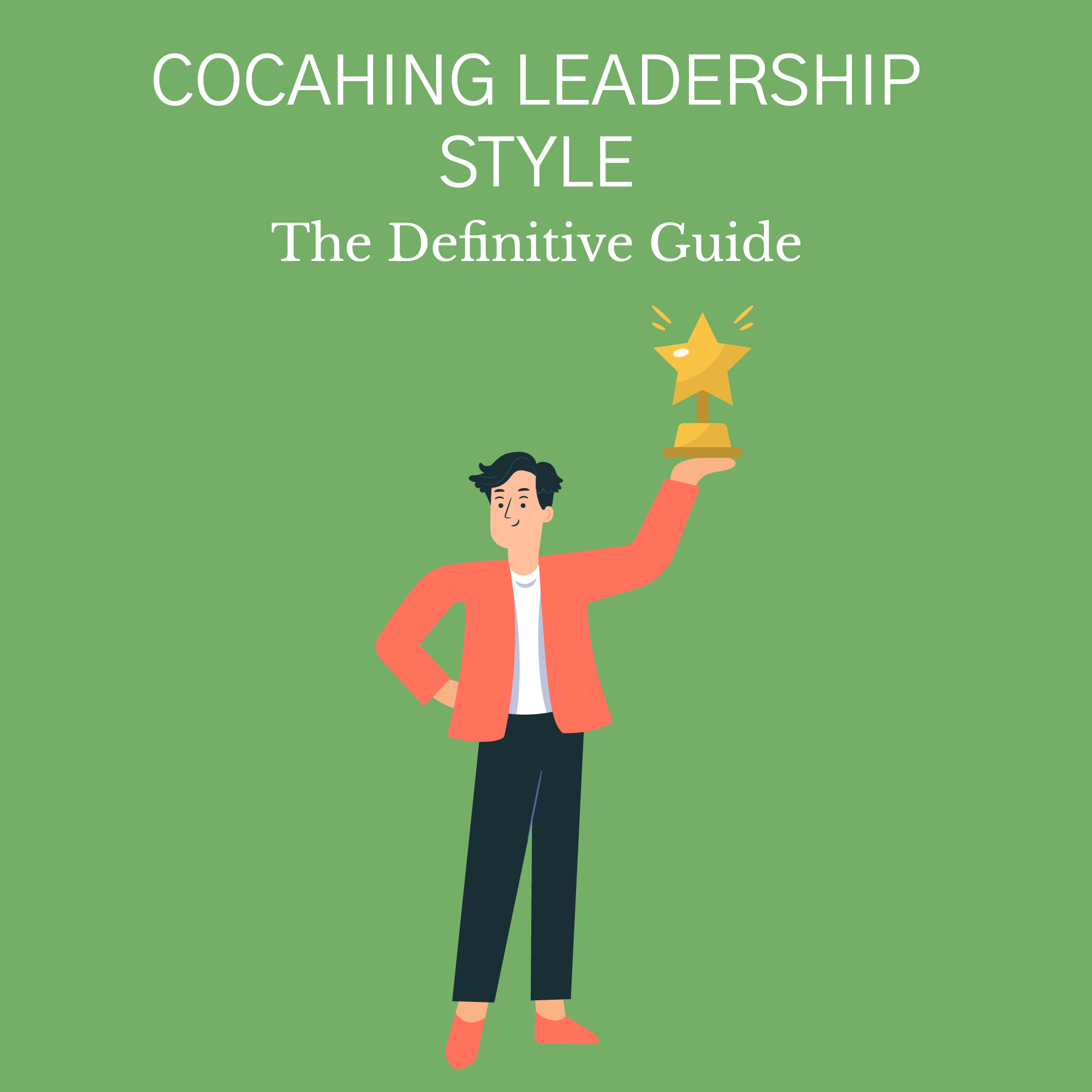Blog » Coaching Models and Techniques » Coaching Leadership Style- The Definitive Guide
Coaching Leadership Style
The Definitive Guide
Leadership is a buzzword being used most often in today’s world. Every child, since being born, is encouraged to be a leader. However, leadership still remains a highly elusive and debated topic for many.
In this guide, you are going to look at one of the most important leadership styles – coaching leadership.
This guide will come in handy if you are looking for:
- Ways to be a successful leader
- Methods to stand out as a coach
- Knowledge about different leadership styles
- A dynamic leadership approach
So, let’s get started!

Don’t have time to read the whole guide right now?

No worries. Let me send you a copy so you can read it when it’s convenient for you. Just let me know where to send it (takes 5 seconds)
Yes! Give me my PDFChapter 1:
The Fundamentals
In this chapter we will look at the basics of Coaching Leadership Style. I will walk you through detailed explanations of what exactly I mean by coaching leadership style and how it differs from other coaching styles.
I will also give examples of some of the most famous coach leaders in the world.

What is the Coaching Leadership Style?
The Coaching Leadership Style has evolved from a transformational leadership theory, which states that in order to help people achieve individual development goals, the leader must support and challenge them.
It is best used when leaders want to build lasting strengths and when people are open and responsive to changes.
As the name states, leaders behave as coaches: communicating well, enabling creativity, and motivating and allowing peers the autonomy to make decisions on their own, leading to a goal well-accomplished.
Coaching Leadership Style is based on long-term strategic thinking; it doesn’t rely on the leader leading, and the others following blindly.
What are the four main Coaching Styles, and how do they differ from Coaching Leadership?
Apart from the Coaching Leadership style, there are three more leadership styles which are used most commonly. Each of these styles has their own benefits and reasons for using them.
However, according to me, the Coaching Leadership style is most effective for a successful coaching career.
Transactional or Autocratic Leadership
Let’s first look at the Autocratic Leadership style, which is commonly called Transactional Leadership style.
Transactional Leadership style follows a “command and control” style of approach, where people are expected to follow the leader without asking any questions. The leader is presumed to know what’s best for the entire team, and is often the one who makes all the decisions.
When you think of a Transactional Leadership style, think of how things typically function in a big corporation. There is a lot of red tape, and team members are expected to stick to their role and follow everything as directed by their boss.
This leadership style leaves little or no room for negotiation, discussion, or creativity and often involves strict monitoring.
You can think of it as being counterintuitive to Coaching Leadership style. They differ from each other in almost every aspect. Autocratic Leadership style is based on controlling and ordering, whereas Coaching Leadership style is based on active communication, support, and garnered help.
As obvious as it may seem, I do not recommend coaches to use this style of leadership with their clients. It will not lead to any long-lasting learning and might end up causing more harm than good in sessions.
To read more about the key characteristics about Autocratic Leadership style, head to this detailed article, ‘Autocratic Leadership: Key Characteristics, Strengths, and Weaknesses of Autocratic Leadership.’
Democratic Leadership Style
Democratic Leadership style, as it states, is one where there is a more democratic approach to leadership.
Leaders let others think creatively and actively come up with feasible solutions to the team’s goals. It is also called Shared Leadership or Participative Leadership.
This leadership, just like the Coaching Leadership style, also evolves from a more emotionally intelligent approach to leadership.
Team members/clients are expected to brainstorm their own solutions and pathways to a goal while the leader/coach guides them in the right direction.
Once all options are evaluated, the leader comes to an informed decision, which the rest of the team applies to reach the goal.
As previously stated in detail, the Coaching Leadership style is a step further than Democratic Leadership, in the sense that coach-style leaders also focus on helping team members/clients achieve personal goals and improving personal strengths in the process of achieving the set external goal.
Coach-style leaders pay close attention to shortcomings and help the client/teammate work on it to fix it.
If you wish to know more about the pros and cons of this leadership style, then check out this descriptive article, ‘Democratic Leadership: Definition, Pros and Cons and Examples.’
Laissez-faire Leadership Style
If Autocratic Leadership lies on one end of the spectrum, Laissez-faire Leadership resides on the opposite end.
In Laissez-faire Leadership, the entire responsibility of every step of goal-setting and achieving is put on the client/team member. The leader practically sits back, while letting others figure out everything on their own.
This leadership style may result in a lot of chaos and confusion and can lead to undesirable results.
Think of it this way: if a client wanted to or was capable of working through their own goals, they would not have approached you to coach them in the first place.
So, it is imperative that you stay away from this style of leadership as well, since it will benefit no one.
However, there are certain situations in which you can make use of Laissez-faire leadership style.
If you are wondering under which environment it might be appropriate to employ this leadership style, then you can read about this in this lucid article, ‘When does laissez-faire management work best?’
When is it suitable to use Coaching Leadership style?
Coaching Leadership style is extremely effective in situations where people lack the skills or knowledge to reach a desired vision, have become satiated or worn-out, and need a fresh perspective to reach the goal. This is a perfect example of why a client seeks out a coach.
Coaching Leadership style helps provide direction and motivation, while developing a “can do” approach that encourages skill development for long-term benefits.
Coaching leaders are tasked with introducing successful ways of aligning personal and organizational goals, all while improving personal accountability. They are tasked with creating a long-lasting impact.
Coaching Leadership style can be employed by coaches while working with clients in various self-developmental stages. It is not restrictive, and will help you help your clients grow, regardless of where they are starting from.
Coaching Leadership style is extremely effective in situations where people lack the skills or knowledge to reach a desired vision, have become satiated or worn-out, and need a fresh perspective to reach the goal. This is a perfect example of why a client seeks out a coach.
Coaching Leadership style helps provide direction and motivation, while developing a “can do” approach that encourages skill development for long-term benefits.
Coaching leaders are tasked with introducing successful ways of aligning personal and organizational goals, all while improving personal accountability. They are tasked with creating a long-lasting impact.
Coaching Leadership style can be employed by coaches while working with clients in various self-developmental stages. It is not restrictive, and will help you help your clients grow, regardless of where they are starting from.
An Example of a Coaching Leader
Coaching leadership, used across various sectors and many times, is referred to as mentoring.
Some of the most successful coaching leadership style leaders are:
- Red Holzman was an NBA coach when he famously mentored another NBA coach, Phil Jackson. He was the reason why Jackson started believing in himself and his coaching abilities. Jackson is also quoted saying on many occasions that Holzman made it easy for him to understand coaching and had a knack for getting people motivated.
- Eddy Merckx, who won the Tour de France five times, used the Coaching Leadership style for Lance Armstrong, who went on to win the Tour de France a whopping seven times!
- C.K. Prahalad, and his entire Windsor Club in India. He inspired and coached the likes of Anand Mahindra, one of the biggest billionaires in the world!
As extensively pointed out in this chapter, the Coaching Leadership style is highly effective for facilitating transformational journeys. It is also necessary to implement a coaching style of leadership if one wants to see longer, sustained results from coaching. And sticking with the characteristics of coaching style of leadership will help one in becoming one of the best examples of a coach leader.
But what exactly are the characteristics of coaching leadership styles?
Let’s dive deeper into that in the next chapter.
Chapter 2:
Characteristics of Coaching Leadership
There are a few defining characteristics of the Coaching Leadership style.
These characteristics will help you in not only applying the correct approach while using the Coaching Leadership style, but also help identify things you need as a coach to be an effective Coaching Leadership style leader. In this chapter, we will look at some of the most defining characteristics of coaching leadership.
Let’s have a look!

Unique Characteristics of Coaching Leadership and a Coaching Leadership Style Leader
Let’s look into some defining and unique characteristics that make a coaching leader.
- Holistic Feedback
A holistic feedback is provided from both ends- the coaching leadership style leader and their teammates/clients about the way of doing. Everyone involved gives and receives constructive feedback and it is implied that they will use it.
- Effective Communicators
Leaders are expected to be ‘effective communicators’ meaning that they have to share, engage, and listen to others involved, all while keeping the end goal in sight and propelling the rest in that direction.
- Intentional Delegation
There is intentional delegation employed by the leader which is meant to be highly effective in the client/team taking full control of their actions. The leader gives others the opportunity to use their strengths to grow their skills and of course gives credit when it is due. The leader is expected to let go of their ‘authoritative’ position.
- Helps Visualize Goals
Coaching leadership style leader helps their client visualize the goals they have set out to achieve, working the role of an active observer as well as a mentor.
- Doesn’t Micromanage
The coaching leadership style leader is not micromanaging things but is rather motivated to enable others to succeed and reach personal and group goals.
- Empathy
Empathy and awareness are a strong attribute and the leader is able to consistently demonstrate it through action and active communication.
- Embodies the Characteristics they Preach
Other defining characteristics embodied by a coaching leadership style leader are collaboration, support, and guidance which are evidently shown in the leader’s approach to everything.
- Promotes Flat Hierarchy
Top-down decision making or hierarchy is extremely flattened as the leader’s goal is to coach and empower others which is best done in a ground up approach.
Usually, the leader encourages the client/teammate to flourish on both- personal and professional fronts.
In Chapter 1, I established that, in Coaching Leadership Style, the leader is expected to be ideally like a mentor.
They, themselves, need to embody all the correct characteristics so that their clients can emulate them to reach higher goals.
The leader is expected to not only bring out the best in their client, but to also ensure that they learn the necessary tools to be self-sufficient one day.
Through years of popular usage in every field, it has been proven that this type of leadership, although may seem a bit difficult to practice, brings out the collective best. Coaches are highly encouraged to follow the Coaching Leadership style. But how exactly does one do that? I will discuss that in detail in the next chapter.
Chapter 3:
How to use Coaching Leadership style effectively?
If you have made it this far, one of the burning questions in your mind might just be, “Well, all of this sounds awesome, but how exactly do I implement it?”
Fear not, I’ve got you covered!
In this chapter, I will discuss at length the steps needed to use Coaching Leadership style effectively.
So let’s get on with it!

A Step-by-Step Breakdown to Unlocking Potential Using Coaching Leadership
Knowing where to begin will assist you in deciding what to do next.
Start by gaining a thorough grasp of your team/client’s present work/personal habits and productivity, and then devise a strategy for coaching them in a way that tackles their concerns, while also teaching the right procedures.
To become a successful coaching leader, follow these steps:
Step 1: Identify Problem Areas
Make time to sit down with your personnel and ask them open-ended questions, to get to the bottom of any problems.
You’ll be better-equipped to conduct fruitful coaching conversations if you do it this way. Speaking with them in person also allows you to gain a better understanding of their viewpoints and how they think.
Some people, for example, have different attitudes and ambitions when it comes to employment. It helps to develop your plan when you have a thorough understanding of distinct personalities.
Step 2: Maintain a Healthy Balance of Praise and Criticism
As a coach, it’s critical to provide constructive criticism, so that clients can understand what to improve on, and how, and what to keep doing.
It’s a good idea to start a critique by mentioning what someone did well. It’s easier to transition into constructive criticism when you start a conversation on a positive note. You can also use the “sandwich method” while giving constructive criticism.
The Feedback Sandwich method is when you put the constructive criticism between two positive things your client did. Think of it this way: the two pieces of bread that make a sandwich will be your positive observations, and the filling of the sandwich will be your constructive criticism.
So, you start off on a positive note, then comes constructive criticism, and follow that up with another positive note.
When giving comments, you should do so in a sincere and sympathetic manner. Inquire about how they prefer to be recognized, as some people dislike being in the spotlight while others thrive on it.
Step 3: Think about One-On-One Sessions
When clients spend one-on-one time with you, they may feel more comfortable speaking up and learning from you. Allow them to use this chance to gauge interest.
Step 4: Look Into Thinking Leadership
Coaching leadership is as much about improving yourself, as it is helping others improve. It takes effort and research to become an outstanding mentor.
If you’re serious about improving your coaching skills, you should seek out as much information as possible. Professional workshops, business books, online tutorials, and other resources can help you learn new approaches and trends.
Make contact with some other pros to see if they would be interested in sharing their coaching knowledge with you.
Successful leaders learn by observation and experimentation, and they are likely to have tips and tactics that would be valuable to you.
Step 5: Set Aside Time to Reflect and Plan
Make time, at the end of the day, to evaluate your coaching efforts.
Examine the feedback you received during your teaching moments, and ask yourself questions about the overall process. Make a mental note of anything you learn, so you don’t forget it later.
Consider any difficulties you’ve encountered, and how you can overcome them.
Step 6: Make Connections with your Clients that Go Beyond Sessions
Coaching necessitates a great deal of trust.
If your clients don’t believe you appreciate them, they’ll be wary of your counsel and hesitant to follow it. Engage in pleasant encounters with them to establish a strong bond.
Maintain a professional and encouraging tone in your comments.
Step 7: Keep your Clients Accountable for their Assigned Tasks
Follow up on the client’s efforts to keep them accountable, once you’ve developed trust and taught them how to work well. Consider holding regular follow-up meetings to ensure that they understand that they are expected to put what you’ve taught into practice.
Consider how you could inspire them by rewarding them based on their performance.
Step 8: Live a Life With a Purpose
Even when you’re not at work, you should make an effort to engage in meaningful relationships with others who may be watching you.
When successful leaders with a coaching approach go home, they don’t switch off their attitude. You need to be a true embodiment of coaching leadership style to emulate it further.
Step 9: In-the-Moment Coaching
Life is full of teaching opportunities that present themselves when you least expect it.
When you take the time to walk someone through a complicated process, or describe a difficult subject, you are providing them with vital information that will benefit their career. Prepare yourself to notice these moments in your life as well, and to be patient when others are learning new things.
Be fully present in sessions, in order to respond correctly to any complications that may arise.
Step 10: Encourage Growth
Another quality of coaching leaders is that they do not chastise clients for short-term failures or errors. Rather, they’re concerned with the long-term success and development of the people they supervise.
As a coaching leader, this entails emphasizing the importance of having a growth mindset, which emphasizes that abilities and intelligence can be developed rather than being fixed.
Clients which develop this perspective will be able to think more imaginatively, be less scared to make mistakes, and feel supported rather than criticized.
Step 11: Pose Thoughtful Questions
Finally, Coaching Leadership is all about empowering people and teams to be their best selves.
Coaching leaders must improve a few critical skills in order to do this. One of these abilities is the ability to ask insightful queries..
Coaching leaders do not tell others what they should do. Instead, they assist people in making the best judgments, or finding the best solutions on their own.
A good method to achieve this is to ask probing questions. The best ways to improve these skills are to practice them on a daily basis, obtain instruction, or seek input from your team on how to improve.
Also, as previously stated, Coaching Leadership is all about two-way communication, so be equally attentive to answering questions in a thoughtful manner.
So, if one wants to be a successful coach leader, they have to identify the correct problem areas of the client and then implement a constructive criticism-based conflict resolution approach. This approach can include steps such as posing thoughtful questions, encouraging growth, being present fully in the moment while coaching, reflecting deeply after coaching sessions, and trying to be empathetic about the client’s situation. Using this approach will surely help you to become a renowned, six-figure earning, coach leader soon!
Chapter 4:
Advantages and Disadvantages of Coaching Leadership
Now that you know all about Coaching Leadership style, and how to use it, I’m going to take you through its advantages and disadvantages.
The advantages are quite obvious, but I want you to pay close attention to the disadvantages, as it will help you create a more well-rounded opinion regarding the
Coaching Leadership style.

Advantages of Coaching Leadership Style
The advantages of coaching leadership I have given here can also overlap with the characteristics of coaching leadership. But one has to consider that in order for these advantages to unlock their full potential, both the client and the coach have to work together in harmony.
Shall we look at the advantages?
- Connection Oriented
Coach leaders have, and develop, a higher level of self-awareness, and are more goal and connection-oriented.
- Personal and Professional Growth is Balanced for Clients
Clients devote more time to information sharing for professional and personal development.
- Increased Interest in Coaching from Clients
Clients are eager to continue coaching and take higher interest in it.
- Heightened Awareness
There is a higher understanding of the difficulties and internal blocks that one is facing, as well as more inventiveness in how to address them.
- Long-term Growth
Long-term, sustained performance increases are possible.
- Higher Connection with all Elements of Life
Clients may take time away from everyday activities, but it benefits them since they are resolving issues in a more hands-on way and are becoming more connected to their environment.
- Increased competence
Clients have a greater sense of competence and receive timely, constructive feedback to help them continue to grow.
- Promotes Two-way Communication
Two-way communication and collaboration are more helpful and less judgmental.
- Increased Creativity
Creativity thrives in a supportive setting.
- High Empathy
Leaders are praised for their enhanced empathy and trustworthiness.
- Exceptional Trust
Rather than a “sink or swim” technique, trust is created over time through gradual learning.
- Coach Clients to Solve their own Problems
Coaching-trained leaders assist clients in solving their own difficulties.
Disadvantages Of Coaching Leadership Style
The disadvantages of coaching leadership are fairly obvious due to the nature of the leadership style itself. Most of the disadvantages revolve around the longer than usual learning curve associated with coaching leadership style and one has to remember to not let the steeper learning curve discourage them from adapting to this style of leadership.
- Longer Result Times
Investing in training and development may result in longer task delivery times and target completion at first.
- More Effort in Comparison to Other Leadership Styles
It takes more time and effort to see benefits, especially in the early phases.
- Difficult to Adopt
In a high-pressure, “get-it-done-now” culture, transformational leadership can be difficult to adopt. Clients that are focused on quick results desire results that are predictable and timely.
- People can be against Criticism
It’s tough to put in place if clients are averse to or scared of receiving negative criticism or any criticism at all.
- Coaching Leaders Need Time to Adapt to this Style of Leadership
Learning how to give effective, concise, and actionable feedback can take more time.
- Higher Time Commitment
Coaches must be willing to devote more time to their clients and be prepared for slower development.
- Coaches and Clients are in Constant Training
This coaching technique necessitates training for both leaders and employees.
- Building CChemistry Takes Times
Coach leaders need to work on developing a good chemistry with their clients to make them feel trusted and supported.
Chapter 5:
Real Life Examples
Now that we have looked at the pros and cons of Coaching Leadership style, the only thing remaining is to take a look at some real life examples.
I am going to discuss two famous companies which use coaching leadership style and then discuss a quick mentorship case study. These are meant to be quick yet super insightful.

Corporate World
Coaching leadership has been a buzz-word off late, but there are a few corporations which have been employing it since years.
Berkeley
This worldwide management consultancy’s partners have all undertaken coaching training. It improves their ability to service their clients, and to respond to challenges that are ambiguous or ill-defined.
They add additional value by understanding that they don’t always have to know the answer, and can instead support clients in finding the best solution for them.
Microsoft
When Satya Nadella became CEO of Microsoft, the corporation had lost its way.
The management mindset was rigid, and the culture was inert. Their mindsets evolved from ‘know-it-all’ to ‘learn-it-all’, thanks to Nadella.
He started by talking to everyone and listening to them, demonstrating his capacity to encourage rather than judge. Instead of avoiding or hiding from mistakes, employees were encouraged to learn from them.
Mentorship Case Study
C.K. Prahalad
I mentioned him earlier in this blog but I am going to expand on him and his work a little bit more now.
CK Prahalad, aka CK, taught at the Ross School of Business.
Two of his main publications, Fortune at the Bottom of the Pyramid and the Core Competence Theory, are likely familiar to many of you.
CK was a leader in action, in addition to his genius as a thought leader.
Between 1990 and 2018, India’s GDP increased from $0.3 trillion to $2.3 trillion. And when you factor in the global GDP that India’s companies provided through their investments around the world, the gain is even greater.
Many people believe that CK’s contribution to this rise is unrivaled. You might wonder how.
After all – he didn’t own any of the businesses that contributed to the increase in GDP.
Well, CK made it his mission to ensure that Indian businesses not only compete with the finest in the world, but also leave a legacy of their own. He was the founder of the annual Bangalore CEO forum, which is today known as the Windsor Club.
It was here that he fostered the Indian business elite.
“He was gathering us like a shepherd gathers his flock of sheep and was fundamentally intent on chastising us for what we hadn’t done and how and what we could accomplish,” Anand Mahindra, an Indian business tycoon, said.
KV Kamath, N Vaghul, Adi Godrej, Azim Premji, Venu Srinivasan, V. Raju, Shiv Nadar, and Ashok Soota were among the pioneer graduates of this club.
All of these companies, like Godrej, Wipro, etc, are now household names in India, with operations in more than 100 countries.
Many of the businesses have grown to be multibillion-dollar corporations. If you ask them where they got their belief and confidence, they’ll point to the Windsor Club sessions.
Perhaps CK’s greatest legacy is coaching tomorrow’s business leaders when no one else believed in them.
Conclusion
I would firstly like to congratulate you for sticking through with me and finishing this whole blog. I do hope that you have gotten a clearer understanding of the coaching leadership style, its benefits, and how to use them!
I always recommend people learn how to be coach leaders because the best way forward is through coaching and coaching thought leadership is the key difference between success and stagnancy.
So, did you find this guide on coaching leadership style helpful?
Do you have any additional questions about coaching leadership style, or anything else I might be able to help you with?
Let me know your thoughts in the comments. If you’d like to access a free course, feel free to comment about it, too.

Download a FREE PDF version of this guide…
PDF version contains all of the content and resources found in the above guide.





















Your posts are always well-supported by research and data.